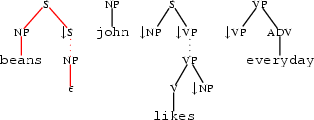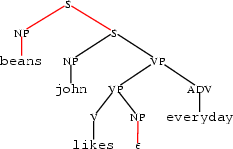4.1.1 DTree Grammar
One application of tree descriptions is in the class of grammars which here we will, a bit loosely, generically call DTree grammars (DTGs) [VS92] [RVSW95a] [RVSW95b] [DT99]. Where Lexicalized Tree Adjoining Grammars (LTAGs) require the non-monotonic operation of adjunction, DTGs instead support the monotonic insertion into holes provided by dominance. For example, here is an elementary tree description for a topicalized NP:

Note how the description introduces a dominance hole (graphically represented by a dotted line) between a sentence node S and a trace NP to be positioned somewhere below (i.e. to stand for the missing NP that was topicalized).
One main attraction of tree descriptions, is that it should be possible to put together several descriptions and then look for solution trees that simultaneously satisfy all of them. Parsing is one application: we would like to select in the lexicon one description for each word and combine them into a syntax tree. Consider our example sentence "beans, John likes everyday" and the following descriptions for each word:

A corresponding solution tree is shown below where the parts originating with the description for the topicalized NP "beans" are shown in red.
